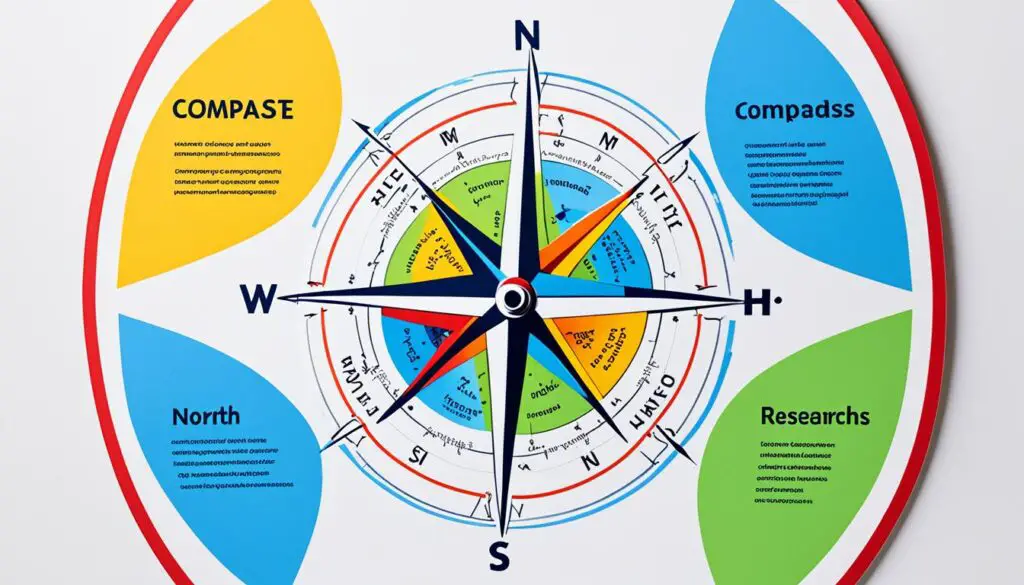Welcome to our detailed guide on creating top-notch mixed methods research studies. This article will give you key insights into the seven crucial design aspects of mixed methods studies. Learning about these factors will help you design studies with deep insights into your research question or topic.
Creating a mixed methods study that is thorough and has impact is important. We’ll look into seven key design aspects:
- Purpose
- Theoretical drive
- Timing
- Point of integration
- Typological versus interactive design approaches
- Planned versus emergent design
- Design complexity
We will also discuss ten extra factors that are important for your study’s design. Taking these factors into account will ensure your mixed methods research covers your goals effectively.
Throughout, we’ll use real case studies. These will show how mixed methods designs can offer deep and full understandings of topics.
Ready to learn and harness the power of mixed methods designs for your studies? Let’s improve your research skills together and reach new heights. Let’s begin!
Key Takeaways:
- Mixed methods research designs are a great way to deeply study research topics.
- The seven key aspects of mixed methods research lay a solid foundation for robust studies.
- Considering purpose, theoretical drive, timing, and more helps in creating effective mixed methods studies.
- Ten more factors add depth to the design process for richer studies.
- Real case studies show how mixed methods research designs work in the real world.
Understanding Mixed Methods Research
Mixed methods research combines parts of both qualitative and quantitative research. It’s to fully understand questions and topics in research. By using data from both types, researchers can better reach conclusions about complex issues.
The Role of Qualitative Research
Qualitative research looks at non-numerical data, like beliefs and experiences. This is done through interviews and observations, providing detailed insights. We learn about human behavior and thoughts this way.
A study might use these methods to see how a job training program affects employees. It would look at their feelings, the program’s effect on skills, and difficulties faced.
The Role of Quantitative Research
Quantitative research focuses on numbers and measurements. It uses statistical analysis to understand a research area. This can include things like age, test scores, and survey answers.
Continuing the previous example, quantitative methods could evaluate the training’s success. This means looking at job improvements, what they’ve learned, and how happy employees are. These hard facts offer clear, unbiased insights.
The Benefits of Mixed Methods Research
This type of research pulls from both qualitative and quantitative methods. It allows researchers to get a deeper, fuller picture of their topic. It’s a way to balance the weaknesses of each approach on its own.
For example, in analyzing a new teaching plan’s effect, we’d get student feedback with qualitative methods. We’d then back this up with numbers, like test scores, to see how well it worked.
This blending helps confirm research findings and strengthen the study’s validity. It gives a more detailed look at the research question.
By integrating qualitative and quantitative data, researchers can uncover hidden patterns, explore contradictions, and gain a more holistic understanding of the research topic.
Data Collection in Mixed Methods Research
Data collection mixes both types of methods. This can happen at the same time, in order, or changing during the study. It all depends on the research’s needs.
Qualitative methods include talking to people and observing. These give detailed, richer info on what the research is about.
Quantitative parts involve surveys or analyzing data already gathered. They look for patterns in big sets of data.
The way data is collected depends on the question and what resources are available.

| Qualitative Research | Quantitative Research |
|---|---|
| Collection of non-numerical data | Collection of numerical data |
| Focuses on understanding subjective experiences | Focuses on measuring and quantifying phenomena |
| Contextual and in-depth insights | Objective and generalizable insights |
Types of Mixed Methods Research Designs
Mixed methods research offers many design options for researchers. This allows them to pick designs that fit their study’s goals. By blending both qualitative and quantitative data, a full picture of the research question emerges.
Convergent Parallel Design
The convergent parallel design looks at both types of data separately but at the same time. This helps see the research from different angles. Comparing results from both types shows if they agree, making the study stronger.
Embedded Design
The embedded design mixes qualitative insights into quantitative data. This method gives a deeper meaning to the numbers by adding stories or experiences. It helps present a full and detailed view of the research.
Explanatory Sequential Design
The explanatory sequential design starts with numbers, then moves to stories and experiences. It helps understand why the numbers show what they show. By getting into the details through stories, the research gets a deeper layer of understanding.
Exploratory Sequential Design
The exploratory sequential design first explores with stories and experiences. This method digs deep into the topic before checking the data. It aims to understand the research question fully before validating the findings through numbers.
Choosing the right research design is key for any study’s success. The method must match what the study wants to find out. It’s crucial to look at what data is available and what the study hopes to achieve. This guides researchers to the best mixed methods design for their study.
Strengths and Challenges of Mixed Methods Research
Mixed methods research blends the best of both worlds, using both word-based and number-based data. This combo offers a fuller view of a topic. It checks and clarifies researchers’ ideas about tough questions by putting both types of data together.
Rather than being stuck with just one way to gather data, this method gives the researcher many options. Methods include talking to people, asking questions in surveys, watching what happens, and setting up tests. This mix of methods lets researchers get a rich set of data. From these data, they’re able to piece together a big-picture view.
When researchers use both types of data, they can create and test out new ideas. They start by looking at the big picture in the stories people tell (qualitative data). Then, they can put numbers to these tales to see if they really hold up (quantitative data). This back-and-forth makes their final conclusions stronger. Plus, it adds to what we know about the subject being studied.
Yet, working with a mixed methods approach isn’t all smooth sailing. It demands a lot of time and effort. Putting both types of data together is no easy task. It involves careful planning and teamwork. Specialists from different fields often need to join forces. This helps make sure everything is covered well.
Figuring out what it all means can also be tricky. Sometimes, the different data types don’t seem to agree. Researchers have to be smart about this. They look closely at how they collected the data and try to find a story that all these facts together can tell. It’s hard work, but it’s necessary to get the right answer.
In short, mixed methods research shines in bringing together two data approaches. It offers a broad range of data gathering tools, lets researchers test out new ideas, and makes for stronger conclusions. Yet, it’s not an easy path. It requires time, great planning, a team effort from different fields, and clever data reading. But, by overcoming these hurdles, it delivers deep insights and a clearer view of a topic.
| Strengths of Mixed Methods Research | Challenges of Mixed Methods Research |
|---|---|
| 1. Combination of qualitative and quantitative data | 1. Labor-intensive process |
| 2. Deepens understanding and validates findings | 2. Interdisciplinary collaboration required |
| 3. Method flexibility | 3. Interpreting conflicting or differing results |
| 4. Theory generation and hypothesis testing |

Advanced Frameworks in Mixed Methods Research
Basic mixed methods research create a good starting point for studies. Yet, advanced frameworks can take this to the next level. These frameworks allow for deeper insights into complex research questions.
Multistage Framework
The multistage framework lets researchers gather data in steps. This method helps them understand the research question more thoroughly. They can change and improve their methods as they gather more data. This process uncovers insights missed in earlier stages, leading to more complete outcomes.
Intervention Framework
The intervention framework looks at intervention impact with mixed methods. It’s great for checking how well programs or policies work. By combining data methods, researchers see the intervention’s effects and the mechanics behind them. This brings a full view of the intervention’s success and points out areas for betterment.
Case Study Framework
The case study framework focuses on a specific case using both types of data. It’s great for studying unique events or detailed phenomena. Through mixed methods, researchers get a strong, thorough look at the case. This method joins deep observations and talks with actual numbers, creating a detailed analysis.
Participatory Framework
The participatory framework stresses on participants actively helping in the study. It values their views and skills, making them research partners. By working together, researchers gather rich, accurate data. This makes the research findings truly reflect what the participants feel and experience.
These advanced frameworks dramatically increase what mixed methods research can do. They let researchers customize their methods to fit their research questions. By using both types of data in these ways, they can better understand complex issues, measure the success of interventions, deep dive into specific cases, and involve participants directly in the research.

| Framework | Description |
|---|---|
| Multistage Framework | Collecting qualitative and quantitative data in stages to gain a nuanced understanding of the research question. |
| Intervention Framework | Studying the impact of an intervention using mixed methods. |
| Case Study Framework | Delving deep into a specific case or phenomenon using both qualitative and quantitative data. |
| Participatory Framework | Involving research participants actively in the research process. |
Conclusion
Mixed methods research is powerful because it uses both numbers and stories. It helps us understand many kinds of questions well. By choosing the right mix of methods and working together, researchers learn a lot.
This method has both good points and challenges. It lets us see things from different angles. But it needs more work and team effort. Understanding the data can also be hard if they don’t match.
Despite these challenges, mixed methods research helps us gain deep insights. It makes our studies richer and more complete. Researchers can make sure their work adds strong new knowledge by using mixed methods well. This method is a key to advancing our understanding of complex issues.
FAQ
What is mixed methods research?
Mixed methods research uses both qualitative and quantitative research. It aims to understand a question or subject deeply.
What are the types of mixed methods research designs?
There are four main types of designs. These are convergent parallel, embedded, explanatory sequential, and exploratory sequential design.
What are the strengths of mixed methods research?
It combines the best of both worlds. By using both types of data, it enriches our understanding and checks the results.
What are the challenges of mixed methods research?
Conducting this research is hard work. It needs different experts and careful merging of data. Sometimes, findings from the two methods may not match up.
What are the advanced frameworks in mixed methods research?
Advanced strategies in this area include the multistage, intervention, case study, and participatory methods.
How can mixed methods research contribute to the existing body of knowledge?
It helps by designing studies thoughtfully and mixing data well. Through this, researchers add to what we already know.








